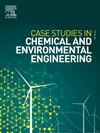Heat stress in landfill environments: Evaluating worker exposure and occupational risks
Q1 Environmental Science
Case Studies in Chemical and Environmental Engineering
Pub Date : 2025-01-04
DOI:10.1016/j.cscee.2025.101097
引用次数: 0
Abstract
Heat stress is a notable occupational health hazard, particularly because global climate change intensified environmental heat exposure. Workers in high-temperature environments, such as landfill sites, encounter significant health risks associated with heat stress, including dehydration, excessive sweating, fatigue, headaches, and potentially more severe conditions. This study examined landfill workers in Yogyakarta, where outdoor conditions increased their susceptibility to heat-related hazards. This study aimed to quantify heat stress in landfill operations via objective data analysis, which refers to the quantitative assessment of environmental heat conditions using the wet bulb globe temperature (WBGT) index, with the goal of informing practical interventions and improving worker health and safety protocols. This cross-sectional study, a type of observational research design, examined data collected at specific points in time. This study involved 39 landfill workers, with WBGT measurements collected at 25 sampling locations in the morning, daylight, and afternoon. This study evaluated the risk of heat stress at various times of the day using WBGT values. The results demonstrated notable fluctuations in WBGT, with peak levels occurring in daylight, consequently increasing the risk of heat stress. Age and body weight are significant factors because older individuals and those with increased body mass exhibit heightened susceptibility to heat retention. Statistical analysis revealed significant differences in WBGT measurements between morning and daylight and between daylight and afternoon (p < 0.001). These findings highlight the necessity for timely monitoring and management strategies to reduce heat stress risk, especially during daylight hours.
垃圾填埋场环境中的热应激:评估工人暴露和职业风险
热应激是一种显著的职业健康危害,特别是因为全球气候变化加剧了环境热暴露。在高温环境(如垃圾填埋场)工作的工人会遇到与热应激相关的重大健康风险,包括脱水、过度出汗、疲劳、头痛和可能更严重的疾病。这项研究调查了日惹的垃圾填埋场工人,那里的室外条件增加了他们对热相关危害的敏感性。本研究旨在通过客观数据分析来量化垃圾填埋场作业中的热应力,这是指使用湿球温度(WBGT)指数对环境热条件进行定量评估,目的是为实际干预提供信息,并改善工人的健康和安全协议。这项横断面研究是一种观察性研究设计,检查了在特定时间点收集的数据。这项研究涉及39名垃圾填埋场工人,在上午、白天和下午的25个采样点收集了WBGT测量值。本研究使用WBGT值评估了一天中不同时间的热应激风险。结果表明,WBGT有显著波动,峰值出现在白天,因此增加了热应激的风险。年龄和体重是重要的因素,因为老年人和体重增加的人对热潴留的敏感性更高。统计分析显示,早晨和白天以及白天和下午之间的WBGT测量值存在显著差异(p <;0.001)。这些发现强调了及时监测和管理策略的必要性,以减少热应激风险,特别是在白天。
本文章由计算机程序翻译,如有差异,请以英文原文为准。
求助全文
约1分钟内获得全文
求助全文
来源期刊

Case Studies in Chemical and Environmental Engineering
Engineering-Engineering (miscellaneous)
CiteScore
9.20
自引率
0.00%
发文量
103
审稿时长
40 days
 求助内容:
求助内容: 应助结果提醒方式:
应助结果提醒方式:


